Best Electronics Heat Gun — Buyers Guide, Review and Comparison
Top Electronics Heat Guns 2024
| IMAGE | PRODUCT | DETAILS | ||
|---|---|---|---|---|
|
Best Rework Station Gun 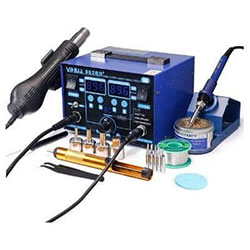
|
Best Rework Station Gun
|
YIHUA 862BD
|
Features
|
Check Price at Amazon YIHUA 862BD Review YIHUA 862BD Review |
|
Best Portable 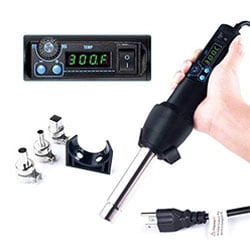
|
Best Portable
|
Maxwell iHGun-1
|
Features
|
Check Price at Amazon Maxwell iHGun-1 Review Maxwell iHGun-1 Review |
|
Best Hot Air Station 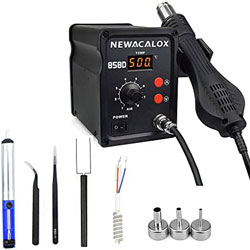
|
Best Hot Air Station
|
Newacalox 858D
|
Features
|
Check Price at Amazon Newacalox 858D Review Newacalox 858D Review |
|
Best Mini Rework Station 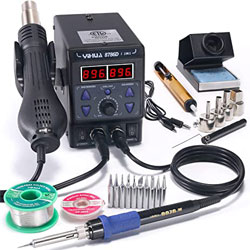
|
Best Mini Rework Station
|
YIHUA 8786D
|
Features
|
Check Price at Amazon YIHUA 8786D Review YIHUA 8786D Review |
|
Best for Precision 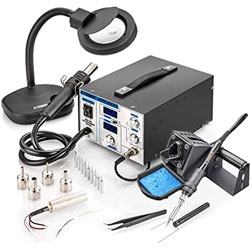
|
Best for Precision
|
X-TRONIC XTR-4040-XTS
|
Features
|
Check Price at Amazon X-TRONIC XTR-4040-XTS Review X-TRONIC XTR-4040-XTS Review |
Heat Gun for Electronics Buying Guide
The truth is, for better or worse, times — and our household appliances — have changed.
In the past, most fairly competent DIYers could deal with the majority of electrical instrument issues. Toasters, lamps, kettles — all were easy to repair, or even build, if you had the inclination.
Today, it’s somewhat different.
Developments in technology have led to many previously simple gadgets now running from a circuit board and microchip — meaning replacement or improvement of their components was the sole realm of the electronic specialist.
But, no longer!
Today, you can purchase affordable electronic-specific heat guns that are straightforward to operate, take up little space, and give you the option to pursue your own circuit board projects — giving you personal satisfaction and saving you money.
When picking out the best heat gun for electronics repair, consider:
Why You Need a Heat Gun for Electronics
At least, that’s the theory.
The problem is that issues — such as short-circuits, incorrectly rated or sub-standard components, sloppy assembly, and even physical damage — can spell the death of your machine. Or, more correctly, put it in a coma.
The only way to awaken your appliance is to remove and replace the offending part.
Heat guns for electronics allow you to safely detach the problem-causing component, and any concomitant solder — easily and cleanly.
Why a Heat Gun for Circuit Boards Is Better than a DIY Heat Gun
To be honest — if you complete minimal electronic work — you probably don’t need a purpose-built hot air electronics machine.
Many of the higher-end DIY heat guns offer suitable temperature ranges and specific nozzles for desoldering components on PCBs (printed circuit boards). These have the advantage of being able to address other household projects too, such as glue removal, car wrapping, and paint stripping.
Hence, if you’re not tackling electronic devices on at least a monthly basis — personally, I’d recommend one of the best digital heat guns instead.
However, if you are a serious gadget freak — you need the correct tool.
Hot air machines for electronics have advantages over DIY units, including:
Size
This makes them easier to manipulate — essential when completing precise work. And, weighing less, you’re less likely to suffer from hand fatigue.
Temperature
Air Concentration and Flow
Furthermore, the airflow from an electronic heat gun is sufficiently powerful to deliver heat to the component — but not so large as it blows solder, or your detached component, across the room. Which is a danger with the hefty, standard-sized guns.
Soldering Capability
How to Choose the Best Heat Gun for Electronics Repair
Hence, I’ve put together what I consider to be crucial considerations when choosing your perfect tool:

Temperature Range
Depending on the tin/lead ratio — these solders have different melting points, and therefore require the hot air gun to achieve the corresponding temperature. For example, a 40-60 (tin-lead) mix needs a heat of 460 degrees Fahrenheit, while a 63-37 blend requires just 364 degrees Fahrenheit.
However, if you’re creating your own circuit boards — and stick to one solder variety — a wider temperature spectrum will not be as necessary.
Form of the Heat Gun
Typically, there are four forms of heat guns for electronics:
- Standard rework station: includes a hot air gun and soldering iron.
- Mini rework station: same as the standard, but smaller and with fewer features.
- Hot air station: a heat gun with a separate station for control — no solder capability.
- Heat gun: all the controls and components are in the gun itself — again, no solder feature.
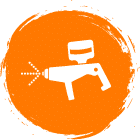
Interchangeable Nozzles
These should be easily interchangeable — you don’t want to be spending hours fiddling around with detachment and attachment. Furthermore, look for those units that can deliver both small and wide heat plumes.
A tight concentration of power is ideal for focusing on individual components, such as resistors and capacitors. A larger expanse of heat is essential for covering more substantial areas, such as heat pad sinks.
Safety and Protection
Personally, as a precautionary measure, I would seek out machines that have overcharging protection, overheating shielders, over-current preventers, and short-circuit protectors.
In addition, those that have an anti-static feature are highly desirable if you’re dealing with microchips and sensitive circuitry. ESD (electrostatic discharge) is akin to hitting a PCB with lightning — wrecking your precious board.
Best Electronics Heat Gun — The Top Five
After checking out industry-expert opinion, the views of electronic enthusiasts, and incorporating my own knowledge and insight — here are my picks of the ultimate heat guns for electronics available.
YIHUA 862BD
Best Rework Station Gun
As a rework station, this is a complete unit for both desoldering and soldering applications. The machine provides a temperature range of 212 to 896 degrees Fahrenheit on the heat gun, and 390 to 896 degrees Fahrenheit on the soldering iron.
Furthermore, its practicality is reinforced by proprietary temperature control technology — which checks the heat level of the gun and iron every 20 milliseconds — ensuring they remain at your chosen setting. And, you can toggle between Celsius and Fahrenheit, depending on your preference.
In addition to being a complete reworking station, the manufacturer has also included a multitude of accessories — meaning you can start your electronic projects straight out of the box. Coming with this unit are four heat gun nozzles, anti-magnetic tweezers, five soldering tips, solder wire, and a desoldering pump.
Both the hot air gun and soldering iron have their own stands — when these tools are placed upon them, they enter sleep mode and cool down. This prevents any accidental burns and increases their longevity. And, as an additional safety feature — should a malfunction cease airflow in the heat gun — it will shut down. This protects the heating coil and minimizes the risk of fire.
- Design
- Functionality
- Price
Pros:
Cons:
Maxwell iHGun-1
Best Portable
As a pure hot air gun — you will require a separate soldering iron for attaching any components back onto the PCB. However — while this machine will not solder — it’s still feature-packed.
Furthermore, rotating a small dial permits you to alter the current fan speed — giving you the freedom to pick your heat delivery intensity. For more impatient DIYers, this gun incorporates a rapid fire-up feature — reaching its operating temperature in around 30 seconds.
To allow you to deliver a concentrated stream on the circuit board — this heat gun for electronics repair arrives complete with three additional nozzles. These should be suitable for most SMD applications in the home.
An insulated body ensures that the unit remains cool in your hand during operation. In addition, an overheating protector prevents the heating coil from reaching temperatures that pose a risk either to you or the function of the machine.
- Design
- Functionality
- Price
Pros:
Cons:
Newacalox 858D
Best Hot Air Station
Our Rating: 4.8
As a hot air station, there are no buttons or dials on the gun itself — thus preventing accidental button pressing. Furthermore, as this reduces the number of components within the handle, it saves weight — making it easier to manipulate and less likely to cause hand fatigue during extended use
An eye-watering rapid heat-up feature means that this gun reaches its operating temperature in just 3 to 5 seconds. And — if you switch the unit off — when you decide to turn it on again, the machine remembers your last temperature setting.
This hot air tool comes with three additional nozzles (8, 5, and 3.2 mm), desoldering pump, and tweezers. However, there is one particular inclusion that requires a special mention. Unlike most machines — this heat station includes a replacement heating coil — the most crucial part of the whole unit.
For safety, this machine features an overload protector, insulated handle, and anti-static construction.
- Design
- Functionality
- Price
Pros:
Cons:
YIHUA 8786D
Best Mini Rework Station
Our Rating: 4.5
Measuring just 5.83 inches by 3.90 inches by 5.28 inches — this mini machine possesses many of the features of its larger cousins — but will fit more comfortably on tables or busy workbenches.
Twin LCD screens indicate the current temperatures — giving a range of 212 to 896 degrees Fahrenheit for the heat gun and 392 to 896 degrees Fahrenheit for the soldering iron. Alternatively — should Fahrenheit mean nothing to you — it’s straightforward to switch the unit into Celsius mode.
Additionally, you can adjust the heat intensity and delivery via multiple fan speeds. A hefty dial, controlling a variable resistor, allows you to make precise adjustments to the airflow.
It’s pleasing to see that this heat gun for electronics also includes everything you need to crack on with your PCB work — you don’t have to go online and purchase additional materials and attachments. Inside the box are four hot air nozzles, ten solder tips, solder, a desoldering pump, and Goot Wick (desoldering braid).
- Design
- Functionality
- Price
Pros:
Cons:
X-TRONIC XTR-4040-XTS
Best for Precision
Admittedly, first impressions are that this is a standard, if somewhat industrial looking, rework station. It delivers a temperature range of 212 to 896 degrees Fahrenheit on the heat gun — and 392 to 896 degrees Fahrenheit on the soldering iron. Furthermore, the fan speed of the hot air gun is controlled by a 16-level rotary dial.
So, nothing out of the ordinary.
Additionally, it includes four heat gun nozzles, nine soldering tips, an IC (integrated circuit) popper to remove delicate chips, and some seriously precise anti-static pinpoint tweezers.
A nice feature of this rework station is the self-test function. It continually checks for issues, such as over-temperature problems, short circuits, and current overloads. Hence, not just keeping you safe — but also increasing the lifespan of this somewhat price-heavy unit.
My main criticism of this heat gun machine for electronics is the control panel layout — which is far from intuitive. For example, while the twin LCD temperature screens are stacked vertically, one heat dial is below and one to the side. Thus, unless you’re familiar with this unit, it can be confusing working out which one control adjusts the heat gun and which the soldering iron.
- Design
- Functionality
- Price
Pros:
Cons:
Conclusion
But if you’re tackling PCBs on a regular basis, or dealing with intricate SMD projects — you need a purpose-built heat gun for electronics.
These precise machines deliver the optimum temperatures, heat focus, and airflow for circuitry work. Thus enabling you to safely remove and replace components without the risks of solder floods and static, and while preventing damage to the PCB.
When choosing the perfect gun, take time to consider your personal requirements. If you need a solder function in addition to the hot air, think about a rework station. For those users who demand pure heat, a handheld compact gun may be more suitable.
The bottom line.
If you want a short cut but not a short circuit — get yourself an electronics heat gun.
Electronic Heat Gun FAQs
Q: How Hot Does an Electronic Heat Gun Get?
The typical temperature for a heat gun for electronics is between 392 to 896 degrees Fahrenheit.
Q: Can I Use a DIY Heat Gun for Electronics?
You can, but ensure that you use a concentrator nozzle and — ideally — an LCD screen that allows you to select an exact temperature.
However, a heat gun that’s purpose built for circuit board work will provide more precise results than a general DIY unit.
Q: What Is a Rework Station?
A rework station generally includes a hot air gun for desoldering and a soldering iron to reattach components.
Q: What Are the Uses of a Heat Gun for Electronics?
Purpose-made electronic heat guns, including those that form part of a rework station, are ideal for:
- Glue soldering.
- Plastic welding.
- Heat shrinking cable sheaths.
- Desoldering.
- Replacing PCB components.
- Salvaging electronic parts.
- Smartphone repair.
- PCB cleaning.
Q: Are Electronic Heat Guns Dangerous?
As these machines emit high temperatures, they do need to be handled with respect and care. Always ensure you select a heat gun for electronics that incorporates features such as overheat and overload protectors.
Q: What’s the Difference Between Electronic Heat Guns vs Digital Heat Guns?
An electronic heat gun is designed purely to work on circuit boards. A digital heat gun, while containing electronic components powering an LCD screen, is a general-purpose DIY machine.
Q: Do Heat Guns for Electronics Have Temperatures in Celsius or Fahrenheit?
It depends on the model. Some machines have temperature readings in just one measurement, while others allow you the choice of either Celsius or Fahrenheit.
